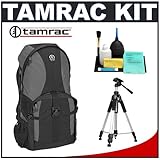 Kit includes:
Kit includes: 1) Tamrac Adventure 10 Backpack
2) Precision Design Deluxe Camera Tripod with Carrying Case
3) Precision Design Deluxe 6-Piece Lens & Digital SLR Camera Cleaning Kit
The Adventure 10 is a modern backpack designed for the SLR photographer with a pro digital or film SLR with a grip and 8" lens attached, numerous additional lenses, a flash, accessories and a 17" screen laptop. The completely foam-padded lower compartment protects photo equipment, while the extra-large top compartment holds a light jacket, lunch or other necessary items. A separate, completely foam-padded compartment provides quick access to a laptop without disturbing photo gear. Double zipper pulls provide quick access to photo gear while a weather flap and quick-release buckle provide security and weather protection. Inside the main compartment, foam pillars support the camera with lens attached while adjustable, foam-padded dividers protect other equipment. Tamrac's patented Memory & Battery Management System uses red flags to identify available memory cards and batteries from ones that are used up. A Windowpane-Mesh pocket organizes filters, cables and other accessories. The comfortable, foam-padded backpack harness with sternum strap is contoured to distribute the weight of the camera gear across the shoulders and features a padded waist belt to help distribute the weight of the pack.
Get maximum image quality and avoid camera shake with this lightweight and sturdy 57-inch tripod, supplied with a fitted carrying case and strap.
This 6-piece cleaning kit contains everything you'll ever need to properly clean your lenses, including a Hurricane Air Blower, Lens Cleaning Tissues, Lens Cloth, Lens Cleaning Liquid, Brush and Cotton Swabs.
Just what are the essentials for the novice birder? Two essentials are a pair of binoculars and the field guide. This is true for backyard birders who largely want to enjoy the birds that come to feeders or birdbaths and for those adventurous souls who take to the field. The field guide is an inexpensive compliment to binoculars which require a bit more consideration.
The field guide-now, that might be a misnomer for those around home birders. Really, this is a resource which helps one learn to identify the birds, wherever they may be. The best guide is one that fits the individual birder's needs and is easiest for him to use. There is no secret formula. Once you've found the one you like, keep it handy and use it often. At first, one should concentrate on just trying to identify the family to which the bird might belong, blackbirds, orioles, finches, woodpeckers, wrens etc. Believe me, it is a significant and meaningful first step; not a difficult one.
A good pair of binoculars is essential to improving one's ability to identify. One can spend any amount of money on binoculars, but one should avoid a cheap pair. We enjoy a time when there is much competition in the optics industry that there are numerous models and types of binoculars. This may have led to confusion for the consumer, but it has also led to increasing quality in optics.
For the beginner, lower magnifications (7x, 8x) are best primarily because they offer a greater field of view. The field of view is the linear feet viewable at 1000 yards. The large field of view is especially important to the novice birder in locating a bird. Higher magnifications help with detail which the more experienced birder may wish to enjoy.
Other aspects of binoculars one should consider include the ease and quickness of focus, the amount of eye relief, weight, closeness of focus, and water and fog proofing. Some of these are self explanatory. However, eye relief is a term worth defining for viewers that must wear eyeglasses. Eye relief has to do with how far images are projected from he ocular lens to their focal point. Eyeglass wearers need 14-15 mm, at minimum. Close focus may be a consideration if one looks for butterflies as well as birds. A close focus of 4.5 to 5 ft is excellent. Water and fog proofing is better accomplished by the newer technology, the roof prism, because focusing can be accomplished internally.
The novice will find that it takes only a couple of items to begin enjoying this pastime. Now, go grab a field guide and your binoculars and happy birding.
Roy Smallwood is the owner of Kingbirdfeeders.com Roy began this enterprise after a 26 year career as a teacher of science. His love and enjoyment of the outdoors and birding in particular is the impetus for the company. He is an active member of the Central Texas Audubon Society. Roy encourages everyone to participate and enjoy birding whether in the backyard or in the field. Happy birding!
Canon SX110 SaleCanon SD880 Best Price
Garmin Nuvi 780 Best Price
No comments:
Post a Comment